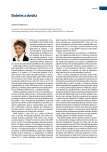Diabesity and sleep apnoea syndrome
Authors:
Viliam Donič 1; Viera Doničová 2
Authors‘ workplace:
Ústav lekárskej Fyziológie LF Univerzity Pavla Jozefa Šafárika v Košiciach
1; Human-Care s. r. o., Interná a diabetologická ambulancia, Košice
2
Published in:
Forum Diab 2016; 5(1): 41-44
Category:
Topic
Overview
Type 2 diabetes mellitus (DM2T) and obstruction sleep apnoea (OSA) represent a medical problem which involves a wide range of physician specialties. The nature of the pathophysiological mechanism underlying the link between DM2T and OSA is still unclear. Prevalence of OSA among the population ranges from 5–15 %, but incidence of OSA among the patients with DM2T or obese individuals reaches 50–80 %. It is assumed that central obesity and intermittent hypoxia in adipose tissue creates the link between DM2T and OSA. The research into diabesity focuses on the role of adipose tissue and agents released from it. There are tissue cultures and animal models used and clinical studies in humans are conducted. However the results are often contradictory and their interpretation is complicated. The aim of this study is to highlight the role of the factors of obesity and hypoxia connected with by OSA in the pathogenesis of DM2T. It includes the latest theories and hypotheses which try to explain some hitherto hidden links and mechanisms.
Key words:
CPAP – diabesity – hypoxia – insulin resistance – obesity – OSA – DM2T
Sources
1. Bonsignore MR, Eckel J. ERS Meeting Report. Metabolic aspects of obstructive sleep apnoea syndrome. Eur Respir Rev 2009; 18(112): 113–124.
2. Bonsignore MR, McNicholas WT, Montserrat JM et al. Adipose tissue in obesity and obstructive sleep apnoea. Eur Respir J 2012; 39(3): 746–767.
3. Pallayova MD, Banerjee D, Taheri S. Novel insights into metabolic sequelae of obstructive sleep apnoea: a link between hypoxic stress and chronic diabetes complications. Diabetes Res Clin Pract 2014; 104(2): 197–205.
4. Polotsky VY, Li J, Punjabi NM et al. Intermittent hypoxia increases insulin resistance in genetically obese mice. J Physiol 2003; 552(Pt 1): 253–264.
5. van den Borst B, Schols AM, de Theije C et al., Characterization of the inflammatory and metabolic profile of adipose tissue in a mouse model of chronic hypoxia. J Appl Physiol (1985) 2013; 114(11): 1619–1628.
6. Huang, LE, Bunn LH. Hypoxia-inducible factor and its biomedical relevance. J Biol Chem 2003; 278(22): 19575–19578.
7. Ryan S, Taylor CT, McNicholas WT. Selective activation of inflammatory pathways by intermittent hypoxia in obstructive sleep apnea syndrome. Circulation 2005; 112(17): 2660–2667.
8. Polak J, Shimoda LA, Drager LF et al. Intermittent hypoxia impairs glucose homeostasis in C57BL6/J mice: partial improvement with cessation of the exposure. Sleep 2013; 36(10): 1483–1490; 1490A-1490B.
9. Pallayova MV, Donic V, Tomori Z. Beneficial effects of severe sleep apnea therapy on nocturnal glucose control in persons with type 2 diabetes mellitus. Diabetes Res Clin Pract 2008; 81(1): e8-e11. Dostupné z DOI: <http://dx.doi.org/10.1016/j.diabres.2008.03.012>.
10. Dawson A, Abel SL, Loving RT et al. CPAP therapy of obstructive sleep apnea in type 2 diabetics improves glycemic control during sleep. J Clin Sleep Med 2008; 4(6): 538–542.
11. Aurora RN, Punjabi NM. Obstructive sleep apnoea and type 2 diabetes mellitus: a bidirectional association. Lancet Respir Med 2013; 1(4): 329–338.
12. Young T, Peppard PE, Taheri S. Excess weight and sleep-disordered breathing. J Appl Physiol (1985) 2005; 99(4): 1592–1599.
13. Goossens GH, Bizzarri A, Venteclef N et al. Increased adipose tissue oxygen tension in obese compared with lean men is accompanied by insulin resistance, impaired adipose tissue capillarization, and inflammation. Circulation 2011; 124(1): 67–76.
Labels
Diabetology Endocrinology Internal medicineArticle was published in
Forum Diabetologicum

2016 Issue 1
Most read in this issue
- New drugs in the treatment of obesity: their availability for clinical practice
- GLP1-analogs – suitable choice in obese patients with type 2 diabetes mellitus
- Nonalcoholic fatty liver disease – a serious comorbidity of diabesis
- Metabolic changes after bariatric/metabolic operations
